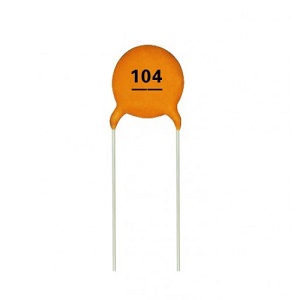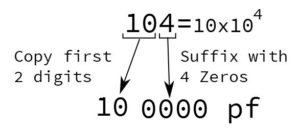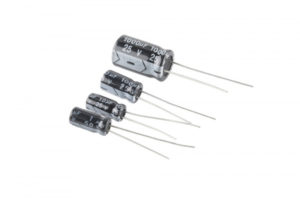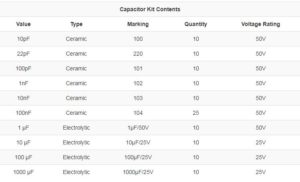How to find a value of Capacitor
A capacitor is a two terminal passive element which stores energy.
There are two types of capacitor.
1. Ceramic Capacitor:

– These are small,non-polarised in yellow or orangish in color.
How to identify these capacitor values:
The value is printed in three-digit code. The first two digits are the two most significant digits of the value, and the third digit is the exponent on the 10. The value is expressed in terms of pico-Farads.
For example,
104 becomes “10” followed by “0000”(four zeros) or 100000 pF, which can be written as 100 nF.

2. Electrolytic Capacitor

– larger cylindrical bodies that look like small soda cans
– higher capacitance than ceramic capacitor
– they are polarized
How to identify these capacitor values and its polarization:
The value is followed by the voltage rating(maximum DC voltage the capacitor can withstand without damage).
Polarization:
There are two polarity indicators on an electrolytic cap:
1. The stripe painted on the body usually denotes the negative lead.
2. The positive lead is longer than the negative lead.
For example,
1000uf 25V – Thousand micr farads and 25 volt.

Author
prathap7618@gmail.com
Related Posts
Ardiuno Projects
~ Sivaraman Arduino projects are done for the learning of embedded systems programming. In simple terms, this supports make projects that are...
Read out allCycle Safety light
For quite a long time (year and a half), kids in the electronics lab have been working on breadboard circuits which they...
Read out allAmbient light sensor using a photoresistor and Arduino Uno
This project is about using a photoresistor along with an Arduino Uno board to determine the brightness of a room which is...
Read out allSmart dustbin using Arduino
The smart dustbin is built on a microcontroller-based platform Arduino Uno board which is interfaced with the Servo motor and ultrasonic sensor....
Read out allA Session with Mr. Thiyaragaraja Kumar
An enthusiast researcher Mr. Thiyaragaraja Kumar visited STEM land on 20th June 2022 to exhibit the projects made by him and to...
Read out allMaximum Power Transfer Theorem
I am doing Prof.Nagendra Krishna Pura’s Basics electrical circuits course provided by NPTEL. In week 6, I learnt about maximum power transfer...
Read out all